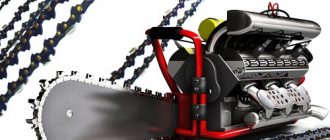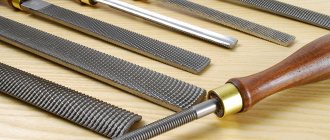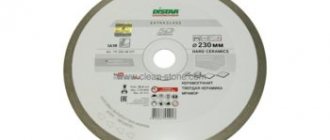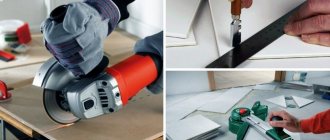What is a riveter and how does it work?
Riveters or riveters are devices for installing rivets. There are special tools for different types of fasteners. There are separate ones for blind rivets. There are also universal models, but they belong to the group of professional tools, and accordingly, they cost a lot.
One use case
To choose the right riveter, it is advisable to understand how it works. Regardless of the type of rivets with which the unit works, the principle of riveting is always the same: the device flares the second (distant) part of the rivet, forming the closing head. Only the flaring method may differ:
- When installing blind rivets, the jaws grasp and pull the rod. At the end of the rod there is a ball that rests against the edge of the rivet body and crushes it. When a certain force is reached, the rod breaks off.
The work of a riveter when installing blind rivets - The installation of screw rivets is different. There is a thread inside the hollow body. A screw of suitable diameter is screwed into this hardware. When twisted, it begins to tighten the edge of the rivet, due to which the ductile metal is flared (see video below).
- When installing hollow rivets (piston rivets), simply flaring occurs with a cone-shaped nozzle. Piston rivets are used in unloaded places, but more often not in construction, but for finishing or when joining parts made of leather, fabric, etc.
Piston rivets are the easiest to install, but they also have the lowest reliability. They are rarely used in construction, except in crafts.
In general, the process is clear. As you can see, the only differences are that in one case you need to pull the rod, in another you need to turn the screw, in the third you press the conical nozzle. When choosing the type of rivets, please note that the tool for rivets is inexpensive, but for screw rivets it usually costs a lot. This basically limits the use of screw rivets. Well, and because they are hollow, they are not airtight.
Principle of operation
A riveter is a type of installation tool that allows you to connect parts together in cases where certain circumstances prevent you from using the classic installation method. Using rivets , you can reliably connect parts, providing them with increased resistance to various types of deformation.
The point of using rivet guns is to flatten the edge of the rivet in a special way so that it can be securely fixed in the mounting hole. Moreover, this work must be done as carefully as possible, without damaging the internal threads.
Using a riveting device, you can fasten together both metal elements and sheets of plastic in combination with other materials. When performing this type of task, it is recommended to use a small washer to evenly distribute the force applied.
The peculiarity of threaded rivets is that they allow not only to fasten several sheets of material, but also to subsequently install bolted fasteners in the place where they are located. This type of connection can also be made on the front side of an already painted wall or any other surface.
The reliability of the connection depends on various factors, not least of which is the outer diameter of the rivet. The larger the fastener, the more reliable and stable the connection between the materials will be. But there is one drawback associated with this point: it is much more difficult to install large fasteners. Often this requires the use of a powerful professional tool.
Modern models of riveters can work with materials with a thickness of 0.3 to 6 mm. To connect them, you can use rivets with different types of heads, including countersunk ones.
Selecting the drive type
Before choosing a riveter, you need to understand what they are. Let's start with the drive.
- Manual (power). To install the rivet, you need to squeeze the handles. Sometimes significant efforts have to be made - for hardware with a diameter of 5 mm or more. The most reliable and inexpensive. This is a justified choice if the tool is purchased for a one-time use - installing roofing material, putting up a fence, sewing up slopes.
When using hand tools, you will have to exert physical effort - Electrical. There is almost no effort - hold the tool and pull the trigger. More expensive, but also more productive models. From the network. Not too expensive, so you can buy them for home use. But not every construction site has a source of electricity, and cords/extension cords are a real hassle.
- Rechargeable. With the same performance, they are more mobile, but they weigh more (the battery itself also weighs), and they are more expensive.
Riveters can be manual, battery-powered, electric, hydraulic
Video review of the MILWAUKEE 2550-20 M12 RIVET TOOL cordless riveter.
For household use, manual riveters are purchased. But even this “simple” tool is not easy to choose. First of all, the range of prices is surprising - from $5 to several hundred dollars. How to navigate here? Let’s say right away that it’s definitely not worth taking something too expensive for a one-time use, just like one that’s too cheap. The rest needs to be figured out.
Types of manual (mechanical) riveters
There are three types of manual rivet setters:
- one-handed;
- two-handed;
- harmonic.
One-handed ones are designed for small fasteners - up to 5 mm. They differ in that their working handles are at an angle of 90° to the installation axis. That is, the handles are pointing down. It is convenient because you can work with one hand. The disadvantage is the small “range” of sizes that the device can work with.
Two-handed ones are large in size; they can also install rivets of large diameters - up to 8 mm. You can distinguish them by their appearance - long handles that are in the same plane as the working jaws. It makes sense to choose a two-handed riveter if you plan to use large diameter rivets.
Types of manual riveters: one-handed, two-handed, accordion
Mechanical accordion riveters are often used with large-sized fasteners. The presence of that very “accordion” allows you to install large-sized fasteners with less effort. Such a device usually has a more expensive tool and is more often used by professionals.
Choosing the type of manual riveter is not too difficult. If you need a reliable machine, choose from two-handed models. Their design is simpler, there is almost nothing to break. At normal quality they are indestructible. If you will only install small fasteners - no more than 2-3 mm, then it is more advisable to use a one-handed one. It's more convenient for them to work.
How does a manual riveter work?
To understand the process, you need to see the rivet in action. The diagram shows its main elements:
The rivet sleeve is placed in the prepared hole. The tool is put on the core and rests against the shoulder of the rivet. The fixed rod is pulled out of the sleeve, riveting its upper part.
When riveting is completed and the head of the core is firmly seated in the riveted sleeve, the core comes off. The riveted materials are connected only by a sleeve.
IMPORTANT! The material describes a mechanical riveter. There are hydraulic, pneumatic and electric devices. However, they are not used in everyday life.
We will also consider the operating principle of the tool itself and its structure in the diagram.
the head (1) is put on the core of the rivet installed in the hole; the body (2) performs the functions of the lower handle and thrust frame; the upper handle (3), resting on the frame with the help of an axis (9), is a power lever; when the handles are compressed, the working sleeve (4) compresses the collet jaws (5), tightly fixing the rivet rod; continuing to move, the collet mechanism pulls the rod out of the rivet sleeve, forming a riveted ring; when opening the handles, the conical bushing (6) under the action of the spring (7) opens the cams, allowing the collet mechanism to take its original lower position; the cover (8) is a stop for the spring and is removed to service the collet mechanism; For the convenience of the operator, interchangeable heads (10) for different rivet diameters are stored in the housing.
Popular: Do-it-yourself profile bending - nothing is impossible
We looked at how the riveter works. In this case, you need to understand how to choose the right connecting elements.
Selection criteria for manual rivet installers
So, if you need to choose a manual riveter, pay attention to the following parameters:
- The type of fasteners with which the unit works (screw, pull-out, piston (eyelets), universal - which installs all types of rivets).
- Maximum and minimum rivet sizes.
- Number of nozzles for rivets.
- The fastener material with which the tool works (steel, aluminum or only copper and brass).
- What is the instrument itself made of? Better - stainless steel or aluminum alloys.
Screw-type manual riveter: pay attention to the dimensions of the fasteners that can be installed
Another thing to pay attention to is the handles. The rubber pads on them should be made of good rubber. The handles themselves should be comfortable for you, so you can work faster and longer. Also pay attention to the possibility of fixing the handles when not in use - there is a special wire loop that holds the handles together. This is convenient and important when storing.
Selecting a blind riveter
Most often you have to work with blind (traction) rivets. They are convenient and inexpensive. The tools to install them don't cost too much either. In addition to the parameters listed above, in order to select a rivet tool for traction rivets, you also need to pay attention to some special characteristics and options.
- Number of clamping jaws (petals) in the collet. The tool grips the rod and pulls it to form the closing head. So, there can be two or three petals. Double-lobed ones are cheaper, but when grabbed, the rod can become skewed and get stuck. You have to take it apart and put it back together again. It’s inconvenient, and time is running out.
There can be several forms - Presence of a ratchet . When working with strong rivets (steel), it is important to correctly calculate the force. A ratchet helps with this.
- Container for collecting broken rods . During operation, the excess rod breaks off. If there is no container, they often end up underfoot and then have to be collected. The presence of capacity solves the problem, but has almost no effect on the price.
Now you know how to choose a riveter for blind rivets. Having selected several models that suit you in terms of characteristics, inspect them and hold them in your hands. If possible, try it a couple of times at work. This will make it easier to understand which tool is more convenient for you to work with and it will be easier to make a choice.
Manual riveter: how to use
To ensure that the use of the riveter does not cause great difficulties, it is worth carefully preparing the necessary parts. Attach them to the surface and make markings. Next, you need to put on construction gloves and make a hole that is several millimeters larger than the size of the rivet. It is better to do this smoothly and carefully. When it is necessary to hide a rivet, it is worth flaring.
The rivet must be inserted into the rivet gun, and its head must be directed into a pre-made hole. Then the working head of the tool is put on and the handles are squeezed. Because of this action, several parts are securely connected.
In order to work with the tool for a long time, you must follow simple rules.
It is worth monitoring the size of the rivets used. Otherwise, the fixation may be very short-lived. When the diameter was chosen incorrectly, the usual compression of the handles may not be enough to secure the materials properly. To install a rivet, you need to press the head of the tool well, and only then squeeze its handles. A variety of materials are used to make rivets, such as steel, stainless steel or aluminum. When it is necessary to achieve a very strong connection, it is better to choose rivets made of the same material as the part. When using a riveter, you should use goggles and gloves to protect yourself from metal parts. Before starting work, you must read the instructions. This will help you avoid making the most common mistakes. It is necessary to thoroughly inspect the instrument. If any of the parts turns out to be broken, it is better to give it to a specialist who can quickly and efficiently repair the riveter.
Due to the rapid development of technology, the use of riveting has become quite simple and does not take much time. The use of a manual riveter helps with this. First of all, this is a very convenient tool that simplifies the fixation of metal parts.
3
Operating technology - how to use the device?
Working with a hand riveter is easy. Everything is done intuitively, the actions are simple and understandable even to people who are going to use the device for the first time. You will need to prepare the metal pieces to attach them to each other. It is advisable to firmly fasten both products so that during work there is no unnecessary movement that interferes with fastening. Mark the places where the holes will be drilled. This must be done very carefully so that the designated places coincide on different elements, otherwise it will not be possible to secure the parts as securely as possible.
When drilling holes, pay attention to the size of the rivet and drill bit. The drill should be several millimeters larger than the size of the hole. If we talk about the length of the rivets, then it depends solely on the load to which the parts will be subjected and their total thickness. The longest rivets, which can be up to 16mm in length, are used for large items, while rivets up to 6mm in length may be suitable for small metal parts.
The thin part of the rivet is inserted into the sharpener so that the nozzle completely matches it. The head is mounted in a drilled hole on the element to be fastened. Important point. On the other side there should be a small protrusion, approximately 10 mm. Perpendicular to the main part, you need to put the riveter on the top of the part. The next action is to press the tool lever as hard as possible. As a rule, one powerful jerk is enough, but if suddenly the leg does not fall off, you will need to press the lever again.
Now we will need to perform broaching using a lever device. We use mounting steel wire for these purposes. The entire space is filled with wire metal. Due to the pressure, small sagging may appear along the edges, which will additionally hold the parts together. The remaining fasteners should be made along the connecting joint. As a rule, it is possible to make up to 4 points, after which the wire breaks. Be sure to remove any remaining wire from the rivet gun; for these purposes, you can use a regular slotted screwdriver.
The size of the parts, the hole, and the riveting itself plays a huge role in the entire process. If you choose the wrong drill, you can significantly deteriorate the quality of the connection of metal parts. As a result, after some time the connection will separate, since it will not be able to withstand the necessary load.
Drill/screwdriver attachment and selection features
When doing a large amount of work using manual riveters, your hands get very tired. Of course, there are rechargeable ones, but the price for them is not at all pleasing. And if you only use it occasionally, it is not advisable to buy a power tool. In this case, you can compromise - purchase an attachment for a drill or a screwdriver for installing rivets.
This is a small adapter (nozzle) that is inserted into the cartridge. They are available for screw and blind rivets. If desired, you can find it for other types of fasteners.
Adapter (nozzle) for drill for installing blind rivets
The principle of operation of a drill with a nozzle for blind rivets is no different - the tool still pulls on the pin, then breaks it off. You just have to get the broken “tails” out yourself, switching the drill to reverse. In the case of using screw rivets, reverse is also required - to remove the nozzle from the installed fastener.
Drill attachment for installing screw rivets
The choice of rivet attachments for a drill is similar: in type, size and material of the attachments. Well, the shank must fit the power tool chuck. Also pay attention to the presence of a handle. This is a non-critical parameter, but it improves ease of use. A drill with a screwed attachment is heavy and unstable. Therefore, when working, be sure to hold the nozzle with your hand, fixing its position. To avoid holding on to the nozzle, put on a handle. In this version, the unit is more convenient to use, and you can more accurately control the position.
How to choose a riveter: manufacturers and prices
When choosing a specific model, many rely on prices. But the spread is very wide - there are very cheap ones and almost identical in appearance, but many times more expensive. Even ten times more expensive. It’s worth saying right away that even for one-time work, buying a very cheap riveter is too risky. It may not work at all or work through the stump-deck.
If you only want to rivet a fence, for example, even then you will have to install hundreds of rivets. If you have to disassemble the tool after every 2-3 rivets, you definitely won’t like it. To choose a riveter that works well, look at the average price range.
- Stanley MR 99. Stanley is the oldest American company.
- NOBUS. Inexpensive tool, works reliably.
- Gesipa. A well-known company, but not everyone praises it. There are definitely cheaper ones that work at least as well.
- YATO copes with steel rivets better than Chinese ones with aluminum ones.
To be able to estimate the price range - NWS is a German company. The quality of the instrument is excellent.
- Topex. In some models I liked the ability to move the “spout” 90 degrees. Convenient if you have to work in hard-to-reach places.
- KRAFTOOL. All the tools are good and so are the riveters.
If you plan to use a riveter in professional activities, you need to choose a more expensive one. The company - at your own discretion, but from the category of professional or semi-professional models. Perhaps they do not differ structurally, but they have a longer resource and service life. That is, they are made more reliably and efficiently. And this explains the difference in price - more expensive/high-quality materials were used.
Which is better to choose a manual riveter?
When carrying out work on connecting parts, it is necessary to determine which manual riveter is best suited for the job. Before choosing the right tool, let's consider what a rivet is and where such a connection is usually used.
A riveter is necessary for connecting parts.
Features of the rivet process
The rivet is a very strong connection. And now you can find perfectly preserved structures held together with rivets. Such products have been serving people for more than a hundred years and are not going to collapse. This method of connecting parts can be found in old production workshops, bridges, and towers. The most famous representatives of riveting craftsmanship are the Eiffel Tower in Paris and the television tower on Shulyavka in Moscow.
Using a rivet bolt, the parts are connected to each other.
Let's look at what the riveting process itself is. The most common example: joining two sheet metal parts flat to each other. To do this, holes are drilled in two adjacent parts, which coincide when the parts are applied. In some cases, if it is possible to fix the sheets in the position in which they need to be fastened, both sheets are drilled simultaneously. This method is preferable because it is more accurate.
Next, the drilled hole is filled with connecting metal. Depending on the diameter of the hole, the connection can be a wire, rod or a specially prepared bolt without thread. If the connecting element is a wire or rod, then they are flared on both sides until the sheets are firmly secured. Usually one side is riveted and then the other.
If special rivet bolts are used, the connection occurs as follows: a rivet with a head is inserted into the hole made. Then, if the dimensions and location of the parts allow, the head is installed on a fixed stop or anvil, and flaring is done on the other side.
The most reliable connection of parts
Riveters have a lever mechanism for operation.
If the design does not allow moving the connection point, a special attachment is attached to the side of the head. The size and weight of the attachment is selected depending on the thickness of the connection and the material of the rivet bolt. And then they do the riveting of the free side. The complexity of the process did not allow such a connection to be used everywhere.
Ideally, the connecting metal should fill the space of the hole made and form caps on both sides that hold the parts together. In the same way, you can not only connect parts together, but also seal holes in one sheet. This method was used by artisans when repairing leaky containers.
This type of connection is very vibration-resistant and, if done correctly, very strong. The rivet differs favorably from other connections in that it does not burst instantly, but gradually stretches.
This quality makes it possible to notice a problem in time and replace the fasteners.
A welding joint, for example, cracks simultaneously along the entire length of the joint, which leads to negative consequences. And compared to a screw connection, a rivet has a much lower price.
New level of riveters
The double-lever riveter is easier to use.
The big drawback of the rivet installation process in the old days was that the rivet needed access from both sides. But progress does not stand still. The invention of a completely new principle for connecting parts brought the rivet to a very popular level of use.
The new generation rivet consists of a tube with a head at one end. A wire with a ball at the other end is placed in this tube. The tube is inserted into the hole until the cap stops. From the same side, a special device grabs the wire and pulls it out. The ball, pressing against the part, flares the tube, forming a reliable fastening.
The most pleasant advantage of the new type of rivets is that the fastening point does not require access from both sides. They can be used to fasten parts in situations where it is impossible to get to them from the opposite side. Also, very thin sheets, which are difficult to firmly connect with screw connections, can be easily connected with rivets.
To install a new type of rivet, a corresponding tool called a riveter was invented. It is a lever mechanism. In appearance, this manual riveter looks like pliers; when working with it, you need to apply force.
Depending on the thickness of the parts to be joined, a blind rivet is selected. The head of a manual riveter is selected to the rivet. The kit usually includes four heads for the most commonly used rivet wire diameters. If necessary, you can purchase more replacement heads.
http:
The head is put on the rivet rod, rests against the head, which fits tightly to the part, after which the riveter handles are compressed. In this case, the collet device grabs the rod and pulls it out of the rivet tube. When the compression of the tube by the return ball reaches its limit, the rod breaks. The rivet is ready. When working, it is advisable not to scatter the bitten off rods, but to store them in a special box.
What other riveters are there?
As you know, progress does not stand still, so the craftsmen tried to further improve the rivet mechanism. A version with an adjustable head is available for sale. This type of design greatly increases speed and makes work easier. With such a riveter it is convenient to work in hard-to-reach places. Today, the tool of this system is the best for use at home or in minor repair work. It is one that can be confidently recommended to craftsmen.
It is also useful to know about other types of manual riveters, since there are situations when you cannot do without a special tool. For example, a threaded riveter. The only difference from the pull-out type is that the ball is pulled into the rivet tube by rotating along the thread. At first glance, this method is just unnecessary expenses. But there are times when it is necessary to screw a bolt into a very thin or fragile plate. In this case, a threaded riveter is indispensable. Of course, there is no need to keep it at home, but you need to know about this kind of connection.
http:
Common versions of manual riveters are used with one hand. But to work with rivets of larger diameter, more force is needed. For this purpose, there are professional two-handed riveters. They are much stronger and designed to work with large diameter rivets. Their dimensions are also larger, so it makes no sense to have them at home.
Such types of riveters as pneumatic and hydropneumatic are used exclusively in production shops - we are not interested in them. Based on all of the above, you can confidently choose a riveter for personal use.
Now all that remains is to note a few working points:
In accordance with the thickness of the parts being fastened and the diameter of the hole, you need to select the size of the rivets. For sheets with a total thickness of 0.5 mm to 5 mm, rivets with a length of 4 - 8 mm and a diameter of 2.4 mm are used. The hole needs to be drilled 2.5 mm. For sheets with a total thickness of 0.8 - 9.5 mm, the rivet length is 6 -12 mm, diameter - 3.2 mm, hole - 3.3 mm. For sheets 1.5 mm - 12.5 mm, the rivet length will be 6 - 16 mm, diameter - 4.0 mm, hole - 4.1 mm. If the wrong rivet is used, a strong connection may not be achieved. An indicator of the correctness of the selected rivets will be the installation of the rivet with one click of the handles. Otherwise, you need to change the size of the rivet. Before pressing the riveter levers, make sure that the head is pressed tightly against the head. It is advisable to select rivets from the same material as the sheets being joined. The industry produces several options: aluminum, copper, brass and steel.
http:
Now you can choose the tool you like. It must be remembered that it is better to purchase this kind of product from a reputable manufacturer. The tool you buy should fit comfortably in your hand. By following the rules, you will choose a reliable and durable manual riveter. And if used correctly, working with it will be a joy.
Source: masterinstrumenta.ru










